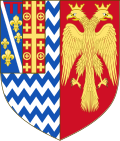| Despot of Epirus | |
|---|---|
 Coat of arms of Carlo I Tocco, founder of the last ruling dynasty of Epirus, as count palatine of Cephalonia and Zakynthos (dexter) and as despot of Epirus (sinister)[1] | |
| Details | |
| First monarch | Michael I Komnenos Doukas |
| Last monarch | Leonardo III Tocco (ruling) Antonio Tocco (titular) |
| Formation | 1205 |
| Abolition | 1479 (fall of the Despotate) 1642 (last use of title) |
| Appointer | Hereditary |
The despot of Epirus was the ruler of the Despotate of Epirus, one of the successor states of the Byzantine Empire in the aftermath of the Fourth Crusade. The name "Despotate of Epirus" and the title "despot of Epirus" are modern historiographical names, and were not in use by the despots themselves. In the Byzantine Empire, the title of despot (Greek: δεσπότης, romanized: despótēs) was a prestigious court title and did not designate rule over some specific territory. Though several of the early Greek rulers of the Epirote realm did use the title of despot, it was never in reference to the lands they governed, but instead in reference to their position in the imperial hierarchy.
It was only with Epirus falling into the hands of foreign dynasties that the title of despot became applied not to the imperial hierarchy, but to the territory, sometimes to the dismay of the local population. "Despot of Epirus" is not recorded in contemporary documents for the rulers of foreign origin, but several other versions are, such as "despot of Arta" and "despot of Ioannina", the two capitals of the despotate at different points in time. Some rulers used the version "despot of Romania" (Romania essentially referring to the territories of the Roman Empire, i.e. Byzantium) or "despot of the Romans" (claiming rulership over the Romans, i.e. the Byzantines/Greeks).
The final despot of Epirus was Leonardo III Tocco, who ruled from 1448 to 1479, when the remnants of the despotate were conquered by the Ottoman Empire. Leonardo escaped into exile and his descendants continued to claim the title until 1642, when the titular despot Antonio Tocco abandoned it and instead claimed the title of prince of Achaea.